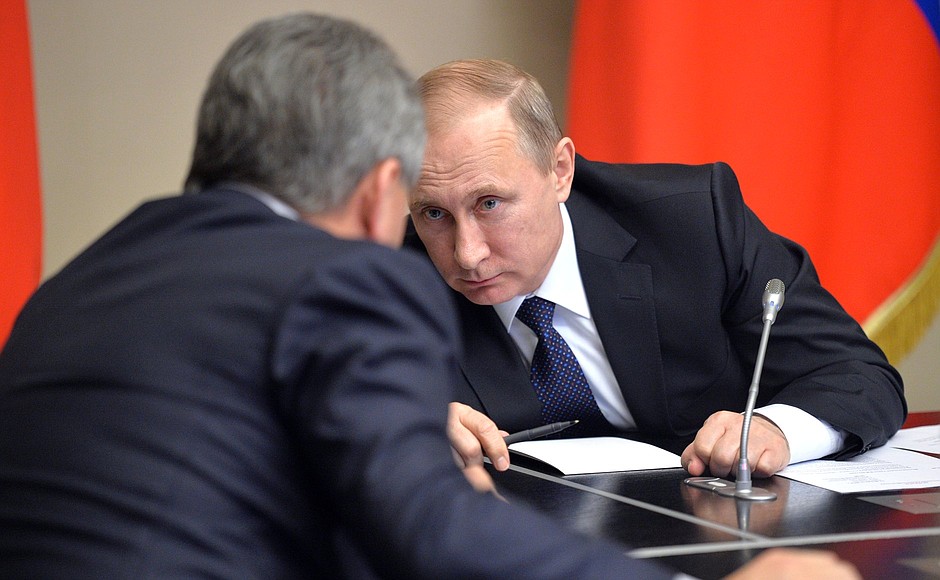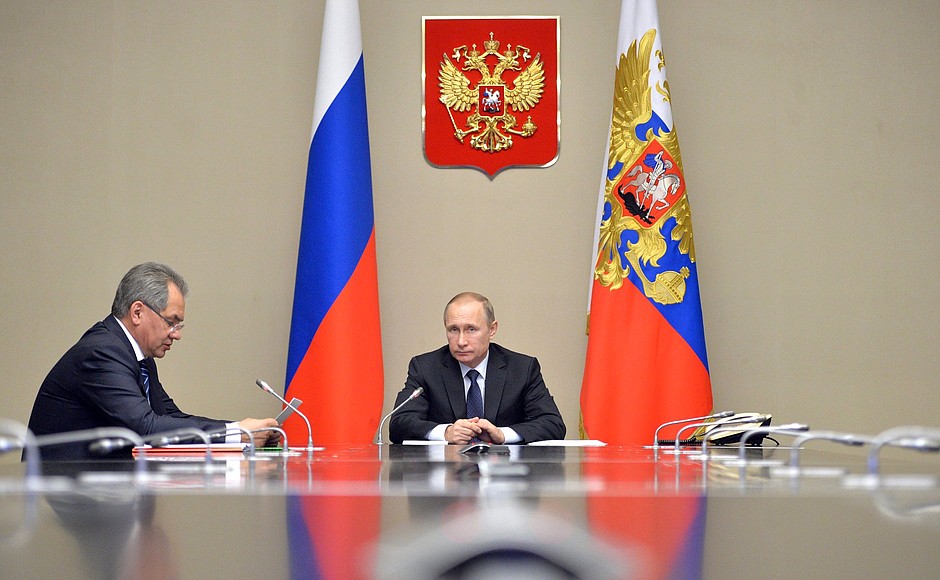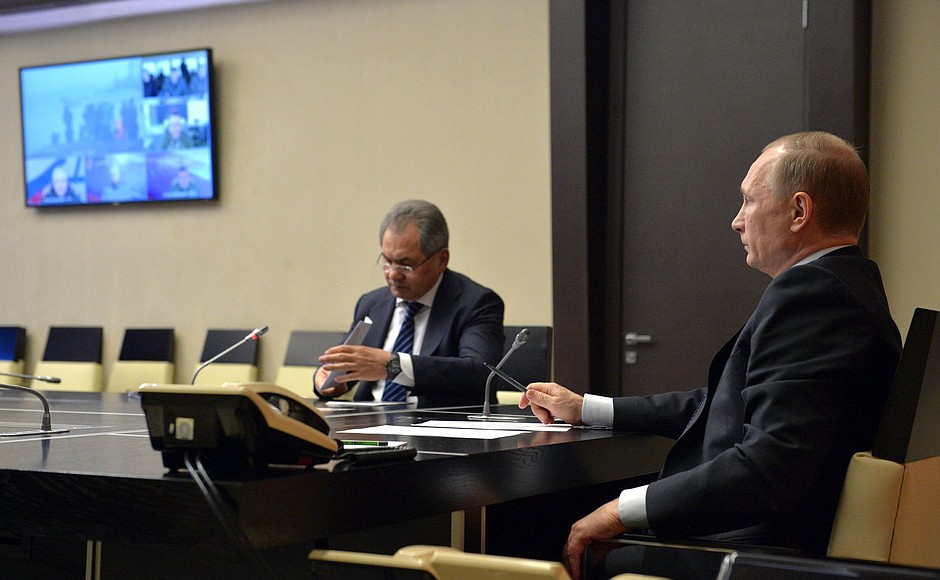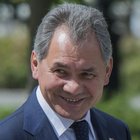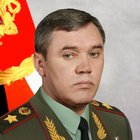The snap inspection of the Southern Military District troops, a number of units of the Airborne Forces and the Military Transport Aviation began on February 8. Taking part in the exercises are up to 8,500 people, 900 units of military equipment, 200 airplanes and helicopters, and 50 ships. The Central Military District forces and equipment are also involved in the manoeuvres.
* * *
President of Russia Vladimir Putin: Good afternoon, comrades.
As you may know, on February 8 we began a complex snap inspection of the Southern Military District forces and troops of the Central Military District, Airborne Forces, aviation, ships of the Black Sea Fleet and the Caspian Flotilla.
I would like to begin by stressing that the personnel are acquitting themselves well, acting in a professional manner and confirming their readiness to ensure Russia’s security in the southwestern strategic direction, including the Crimean Peninsula.
I would like the Defence Minister and his colleagues on location to report what they are working on, what forces are deployed, how the units are interacting and how the modern equipment and armaments the troops are receiving are performing.
As we agreed, we need to continue the practice of such snap inspections. We can see that they have proven successful, making it possible to consistently raise the combat readiness of the army and navy and the forces’ concerted action.
Let us proceed to your report. Mr Shoigu, please.
Defence Minister Sergei Shoigu: Comrade Supreme Commander-in-Chief,
Pursuant to your instructions, another snap complex inspection is being held in the Armed Forces from February 8 to test combat readiness. Troops and forces of the Southern Military District, units and military installations of the Central Military District, Airborne Forces and Military Transport Aviation have been put on high alert within the fixed limitations and have commenced performing their combat exercise tasks.
To test the control system down to brigade level, field and mobile control points were set up in the Southern and Central Military Districts. To train the deployment of territorial defence, headquarters have been set up for the defence of Rostov Region, Sevastopol and Simferopol.
The troops and forces taking part in the exercises were redeployed to a distance of up to 3,000 kilometres to 18 testing ranges, and the armed group in Crimea has been reinforced. Aviation and air defence forces are ready to repel a mass air strike by the hypothetical aggressor. A control system has been set up in the combat zone, along with logistic and medical support with the use of mobile units. Operational coordination was carried out.
We organised the security and defence of engineering equipment at troop deployment locations. Reconnaissance was carried out in the areas of future action. We completed the planning of the use of troops and forces to implement training combat missions. Since February 9, the troops have been working on practical assignments in localising crisis situations linked to terrorist attacks, seizure of state and military facilities and the destruction of hydraulic engineering works.
Today the snap inspection entered its final stage involving 29 exercises at various levels. Currently combat training is being conducted at the Opuk testing range. Bilateral tactical exercises of the Black Sea Fleet and Airborne Forces are to practice defending the coastline and repelling a sea landing operation. In addition, air defence units and fighter aviation located in the Crimean Federal District are repelling a massive air strike by the hypothetical aggressor.
The Chief of the General Staff will report on the current stages of the snap inspection. I also suggest hearing reports from the commanders of the Black Sea Fleet, the Central Military District troops and the 58th Army.
Vladimir Putin: Mr Gerasimov, please.
Chief of the General Staff Valery Gerasimov: Comrade Supreme Commander-in-Chief,
Over the past three days, the troops and forces involved in the snap inspection have taken a series of steps to achieve complete combat readiness. They have performed all exercises required to prepare for combat, liquidate illegal armed groups, localise crisis situations on the territories of the Southern and North Caucasus federal districts and repel a hypothetical aggression.
Up to 8,500 personnel, 900 units of military equipment, 50 naval vessels and up to 200 airplanes and helicopters were used within the boundaries of the Southern Military District in combat training, which is in keeping with the Vienna document of 2011. Within the established timeframe after an alarm call, units and military commands were deployed to the appointed locations.
(Then the Chief of General Staff gave a detailed report on the snap inspection of the combat readiness of troops and control systems on the territory of the Crimean Peninsula, in the Southern and Central Military Districts and of the actions of tactical aviation, combat ships and support vessels.)
Overall, the re-grouping and relocation of aviation and the inspection confirmed the readiness of the troops to perform tasks to ensure the combat security of the Russian Federation in the southwestern strategic area.
By the start of the third stage, 29 exercises were prepared with the involvement of military units and installations of the 49th and 58th armies, the Black Sea Fleet and Airborne Forces. Today in the course of combat training in the air, air defence forces and fighter aviation located on the territory of the Crimean Federal District repelled a hypothetical massive air missile strike. Bombing practice was successfully carried out at the Opuk range.
Forces of the Black Sea Fleet and the Caspian Flotilla have been deployed in the area of marine testing, where exercises continue with the groupings to ensure a favourable operating situation in areas of responsibility and protect underwater state borders and navigation. In addition, the Black Sea Fleet will practice in inflicting damage on the hypothetical aggressor’s naval forces.
Vladimir Putin: Mr Gerasimov, how many servicemen, ships and aircraft are involved in the exercises?
Valery Gerasimov: In compliance with the Vienna agreement, we have 900 units of military equipment, 50 combat vessels and 200 airplanes and helicopters involved here on the borders of the Southern Military District.
Vladimir Putin: Thank you.
Mr Vitko, please.
Black Sea Fleet Commander Alexander Vitko: Comrade Supreme Commander-in-Chief of the Armed Forces of the Russian Federation,
On February 8, the Black Sea Fleet was brought to full combat readiness. We have formed land, sea and air groups to defend Crimea. The troops and forces of the fleet have been enhanced by Aerospace Forces’ and Airborne Forces’ units and commands. On February 9, we commenced tactical exercises, during which we plan to conduct 300 combat exercises in various environments.
Currently, bilateral tactical exercises are taking place at the Opuk range and adjacent water area, where conflicting sides are involved in training anti-airborne defence and marine landing operations.
A coast guard brigade is holding the coastline. Marines are landing from large assault ships and attempting to seize a foothold on shore. Supporting the landing troops in the fight for the landing are fire support ships and assault aviation. The first echelon of the landing forces includes large assault landing ships Novocherkassk and Tsezar Kunikov with marine units and close defence ships Zeleny Dol and Serpukhov. The use of new ships and submarines has increased the capability of the naval group.
Taking part in the airborne assault echelon landing are units of the Airborne Forces and special purpose fleet.
Later we plan to hold missile and artillery range practice with the participation of coastal missile troops and artillery.
Following the exercises, we will assess every serviceman. This data will make it possible to achieve cohesion within a grouping of different types of armed forces, which will undoubtedly ensure the solution of the tasks before us.
Vladimir Putin: Thank you, Mr Vitko.
How did the new missile ships and submarines perform?
Alexander Vitko: The potential of the small ships is two to three times greater than of previously built ships. They have significantly enhanced the fleet’s capability. Thank you for building them
Vladimir Putin: Good. Convey my best wishes to the crews.
Mr Zarudnitsky, Commander of the Central Military District, please.
Commander of the Central Military District Vladimir Zarudnitsky: Comrade Supreme Commander-in Chief of the Russian Federation Armed Forces,
At 8.30 a.m. on February 8, military control bodies of the Joint Strategic Command, units and forces of the Central Military District were placed on full alert with set limitations. I am now at a mobile field district command post located one kilometre to the northeast of the town of Verkhnyaya Pyshma in Sverdlovsk Region.
1317 units of control and support equipment have been deployed at the ranges. On the territory of three federal districts within the Military District, we have deployed 63 field control posts. We completed fortification in the regions, practiced the organisation of security and defence, camouflage and protection against means of destruction. In the areas of greatest potential threat, the control posts are covered with engineering obstacles.
Against the backdrop of the combat developments with the use of up-to-date automation devices, we conducted training in data exchange within control posts with senior and subordinate headquarters, including the Russian Federation National Defence Control Centre. Twice we changed the location of command and auxiliary control posts. The total length of displacement routes was over 4 thousand kilometres. The tasks were implemented. The control system is ready to ensure efficient troop management in the Central Military District in various conditions.
Vladimir Putin: Thank you.
Mr Zarudnitsky, how long did it take the units and groups to leave their permanent locations and start moving towards the locations?
Vladimir Zarudnitsky: Comrade Supreme Commander-in-Chief, troops leave their permanent location within an hour of the signal.
Vladimir Putin: Thank you.
Mr Gurulyov please, Commander of the 58th Army of the Southern Military District.
Commander of the 58th Army of the Southern Military District Andrey Gurulyov: Comrade Supreme Commander-in-Chief of the Russian Federation Armed Forces,
Since February 8, the units and troop commands of the 58th Army have been performing tasks to achieve full combat readiness. Units of the 17th and 18th motorised infantry brigades, the 100th brigade and the 12ht missile brigade have marched to the Sernovodsky testing range and are successfully engaged in exercises to block and destroy illegal armed formations and deal missile blows against the hypothetical aggressor.
Reconnaissance and special purpose units of the 8th, 15th and 19th brigades in cooperation with Internal troops and Interior Ministries of the Chechen Republic and the Republic of Ingushetia are acting on the operations headquarters plan in the Sudjansky Region of the Republic of Ingushetia and the Urus-Martan Region of the Chechen Republic. The other units of the army are conducting tests in combat training on army ranges.
Comrade Supreme Commander-in-Chief, the 58th army is prepared to achieve the set targets.
Vladimir Putin: Thank you very much.
Mr Gurulyov, you mentioned interaction with local law enforcement agencies and other state control bodies. How is it working? How is this joint work proceeding?
Andrey Gurulyov: Comrade Supreme Commander-in-Chief, we have organised constant daily and hourly interaction. All contacts are maintained and all problems are solved.
Vladimir Putin: Thank you.
Comrades, I wish you all a successful completion of the work. Convey my best wishes to your personnel.
